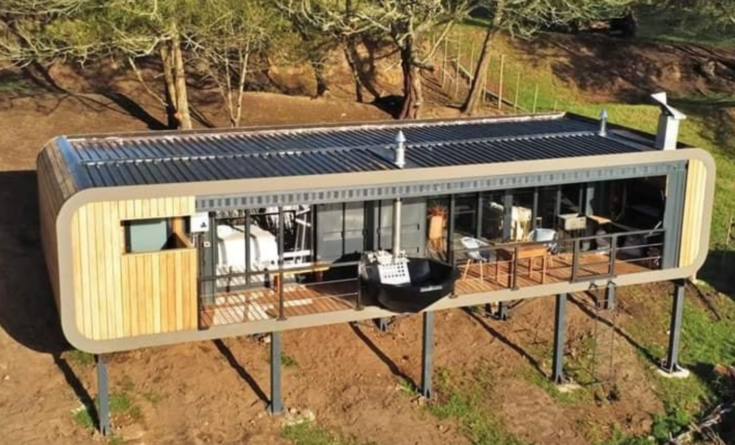In recent years, an alternative and innovative housing trend has gained significant attention and popularity: shipping container homes and prefab homes.
These distinctive homes, built from salvaged shipping containers or factory-made components, provide a viable and affordable solution to the housing crisis that many people are currently experiencing.
With their sleek design, quick construction process, and eco-friendly benefits, these homes have captured the imagination of architects, homeowners, and environmentalists alike.
In this article, we will take a closer look at shipping container homes and prefab homes, exploring their benefits, challenges, and potential as a viable housing solution.
Whether you are a design enthusiast or someone considering alternative housing options, this article will provide valuable insights into these intriguing home options.

Key Takeaways
- Shipping container homes are houses created using old shipping containers, while prefab homes are houses built in a factory and then transported to the construction site.
- Shipping container homes and prefab homes are two popular options for affordable and sustainable housing.
- Shipping container homes have a modern and minimalist look, while prefab homes offer more design choices and customization.
- Both shipping container homes and prefab homes can provide a more affordable housing option compared to traditional homes, but it’s important to consider the overall cost, including transportation and installation, when making a decision.
- The choice between the two ultimately depends on your personal preferences, budget, and location. Consider the pros and cons of each option before making a decision.
What is a shipping container?
Shipping container homes are houses that are created using old shipping containers. These containers are typically used to transport goods around the world. However, they can be repurposed and turned into unique living spaces.
These homes are built off-site and then transported to their final location. They come in different sizes, ranging from small and compact to larger homes made from multiple containers. The size of a shipping container home depends on the number of containers used and the design chosen.
Inside, these homes can have all the amenities you’d find in a regular house, such as a kitchen, bathroom, and living spaces. Each square foot within the container is used to maximize space efficiently.
These homes also offer great flexibility and can be customized to fit individual preferences and needs.
Whether you prefer a small and cozy home or a larger one with plenty of room, shipping container homes can be designed to suit your taste.
They provide a unique and sustainable housing option, repurposing materials that would otherwise go to waste.

What is a prefab home?
Prefab homes are houses that are built in a factory and then transported to the construction site. They’re a popular choice for people who want an affordable and hassle-free way to build a home. These modern prefab houses offer a range of options, from tiny homes to custom designs.
One of the main advantages of prefab homes is their cost-effectiveness. Since the parts are manufactured in a factory, the construction process is efficient, reducing labor costs. This makes prefab homes a great option for those on a tight budget or looking to save money.
Another benefit of prefab homes is their quick construction time. Since the parts are pre-made, the building process is much faster compared to traditional construction methods. This means you can move into your new home sooner and start enjoying it without the long wait.
Prefab homes are also known for their simplicity of design. This is because they need to be easily transportable, so they often have a more minimalist aesthetic.
However, this doesn’t mean you have to sacrifice style or functionality. Many prefab homes offer customization options, allowing you to create a home that suits your taste and needs.
Prefab homes can also be eco-friendly. Some prefab houses are made from repurposed materials, such as shipping containers, which reduces waste and promotes sustainable living. Many prefab homes also feature a steel frame, ensuring durability and stability.
Whether you’re a first-time homeowner or someone looking for a unique and environmentally-friendly living solution, prefab homes are definitely worth considering.
They offer affordability, efficiency, and customization options, making them a great choice for those seeking a simple and convenient way to build their dream home.

Prefabricated House from TD Container House
Differences Between a Shipping Container Home and a Prefab Home
When comparing a shipping container home to a prefab home, there are several important differences to consider. Let’s explore them in detail.
Sustainability
A container home is a more eco-friendly choice. By repurposing shipping containers, you’re helping to create a more sustainable future. These homes are made from recycled materials, which reduces the need for new resources.
Container homes also offer custom options for insulation, allowing you to create an energy-efficient living space.
On the other hand, prefab homes often use all-new materials, which can have a negative impact on the environment.
While prefab homes can be made with sustainable materials, they usually require more resources and energy to produce.
In terms of sustainability, a container home is the clear winner. It offers a more environmentally friendly option for your housing needs.

Customization Options
Looking for a unique home design? Consider the distinctive look of a shipping container home compared to a prefab home.
Shipping container homes offer endless customization possibilities, allowing you to bring your dream home to life.
Unlike prefab homes, which have limited pre-designed options, custom container homes give you the freedom to choose the layout, size, and number of containers. This way, you can create a home that perfectly suits your needs.
Whether you prefer a modern style or a rustic charm, shipping container homes allow you to achieve a truly unique look.
With their customizable and distinctive appeal, you can stand out from the crowd and have a home that reflects your individuality. From sleek and contemporary designs to cozy and traditional aesthetics, the options are limitless.
Price
When deciding on your housing options, it’s important to consider the cost difference between a shipping container home and a prefab home. The price contrast between the two options is significant.
If you’re looking for an affordable alternative, a shipping container home is a budget-friendly option. You can expect to spend anywhere from $10,000 to $30,000 on a shipping container. This lower cost makes it an attractive choice if you want to keep your expenses to a minimum.
On the other hand, prefab homes generally come with a higher price tag. The cost of a prefab home ranges from $75,000 to $150,000.
Although this may seem expensive compared to a shipping container home, prefab homes offer more customization and floor plan options. This makes them suitable for both residential and commercial purposes.
Keep in mind that financing options may vary for each type of home. You should consider your budget and financial capabilities carefully when deciding between a shipping container home and a prefab home.
Size
Size is an important factor to consider when comparing shipping container homes to prefab homes. Container homes are limited to the dimensions of a single container, usually around 8 feet wide. This narrow width can make it challenging to create spacious living areas.
In contrast, prefab homes offer more room to move around. They’re designed like traditional houses, providing both horizontal and vertical living space.
Even if you combine multiple containers to create a container home, it still won’t match the size of a prefab home.
Prefab homes can be customized to fit your specific needs, whether it’s adding extra bedrooms or enlarging the living room.
This flexibility in design allows you to create a home that suits your preferences and accommodates your family’s needs.
If you have a large family or desire more living space, a prefab home might be a better option for you. It provides the opportunity to have ample space for everyone to live comfortably.
On the other hand, if you prefer a more compact living arrangement or have a smaller household, a shipping container home could be a suitable choice.
Ultimately, the size of the home you choose depends on your individual requirements and preferences.
You should keep in mind the number of people living in the home, the activities you plan to do, and the amount of space you need when choosing between these two types of homes.

Should You Choose Container Homes or Prefab Homes?
Ultimately, the decision between container homes and prefab homes depends on your preferences, budget, and the local regulations in your area.
If you’re looking for a cost-effective and durable option, container homes may be the way to go. However, if you desire more customization and flexibility, prefab homes offer a wider range of choices.
Consider your priorities and consult with professionals in the field to make an informed decision. Both container homes and prefab homes have their own unique benefits, so it’s important to choose the option that best fits your needs and circumstances.

Container Homes and Prefab Homes as Alternative Living Spaces
Shipping container homes and prefab homes offer affordable and sustainable housing options. Shipping container homes have a modern and minimalist look, while prefab homes provide more design choices and customization.
When deciding between the two, you should carefully consider your preferences, budget, and location. The choice between the two ultimately depends on these factors, after all.
Whether you choose a container home or a prefab home, both options offer unique advantages and considerations to keep in mind.
If you are interested in learning more, feel free to visit our guides here.


